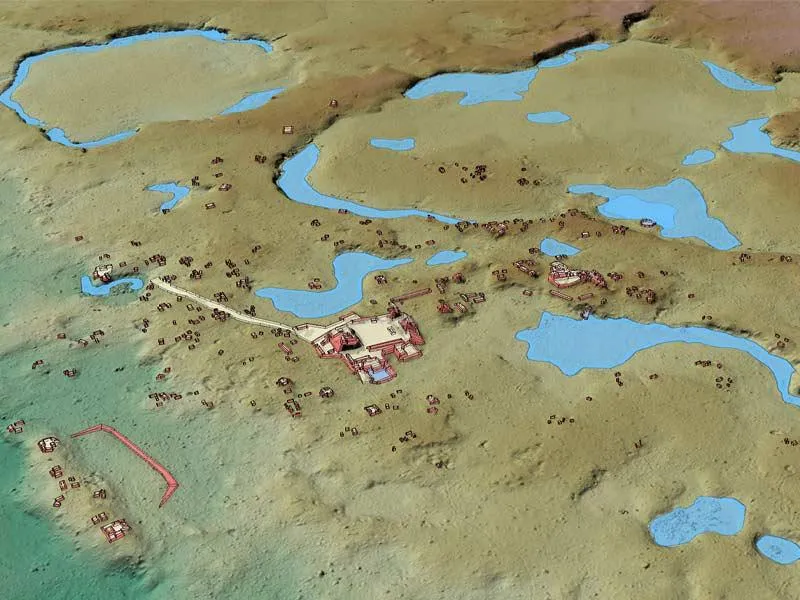
Since its founding in 1924, the Middle American Research Institute (MARI) at Tulane University has led the way in its study of Mexico and Central America. Today, as MARI reaches its centennial, generous gifts from two previous donors insure the future of this landmark institution. Funding from the Effinger Family and the Hitz Foundation support a new chapter of innovation and archeological technology at MARI, and affirm the institute’s mission to preserve and promote greater understanding of the indigenous cultures of Mesoamerica.
As an undergraduate at Tulane, Lt. Col. Clinton Effinger III (A&S ’49) credited MARI for cultivating his lifelong passion for archeology. In 2019, his wife Yvonne Effinger made a gift to MARI to commemorate her dear late husband. High school sweethearts reunited in mid-life, Clint and Yvonne Effinger shared in a love of cultural learning. They were avid travelers during their nearly forty years of marriage, and collected antiques and artifacts as Clint’s military posts and further travel brought them to Asia, Europe, and the Middle East. Yvonne's $30,000 gift went to improving MARI’s storage facilities, protecting thousands of precious artifacts, including some donated by Clint decades ago.
Now, their children have established an endowment in both their parents' names, forging a lasting bond between the Effinger family and MARI, ensuring their legacy lives on within the institute.
“In a modern world where many cultures are instantly interacting electronically, we see Dr. Canuto’s efforts as a bridge to overcome barriers to cultural understanding and collaboration. In honor of Clint and Yvonne Effinger, we wish for the Clint and Yvonne Effinger Excellence Endowed Fund to support Professor Canuto and MARI: inspiring a legacy of cultural respect and understanding for students and citizens of the world,” says Yvonne’s son Chris Flynn, speaking on behalf of the family.
Yvonne was able to visit Tulane and MARI in 2019; next week, her family will return to meet with MARI Director and Professor of Anthropology Marcello Canuto and visit MARI’s facilities in Dinwiddie Hall. The third floor of the newly renovated hall is home to MARI’s gallery space, and its inaugural exhibit "Faces of the Maya: Profiles in Continuity and Resilience,” on the Maya civilization from 1000 BC to present, which is currently open to the public.
From its early days, mapmaking has been central to MARI’s endeavors, though what this looks like has changed greatly over the years. Early mapmaking relied on exploring and trekking for miles through the jungle on foot — one of MARI’s early directors, Francis Blom, conducted expeditions that led to the first archeological map of the Mayan region.
Today, MARI is a leader in archeological innovation, with their utilization of Lidar, a mapmaking technology which has revolutionized the field. Lidar, which stands for light detection and ranging, is a remote sensing method that makes it possible for archeologists to identify buildings, walls, and other human-made structures under the thick canopy of the jungle and dense obstacles. An early leader in this technology, Canuto and Tulane Research Professor Francisco Estrada-Belli were part of a 2018 team that discovered dozens of ancient cities in Guatemala, including some 60,000 structures.
“Until basically 2016 when we got the first Lidar data set, Mayan archaeology had combined, in ground surveys and maps, to roughly 700 square kilometers,” explained Canuto in an earlier interview. “This means walking through the jungle, finding each archaeological site, and putting it on a map. Since 2016, we, as part of a consortium, have conducted a Lidar survey of over 7,000 square kilometers — 10 times more than what had been surveyed using traditional methods.”
MARI analyzes and computes archeological data in its Geographic Information Systems (GIS) Lab, created with help from a 2019 Hitz Foundation grant. Building on this initial gift, the Hitz Foundation renewed its support of MARI’s mapmaking with this latest grant of $1.5 million.
This continuous support enables the GIS Lab to grow, and to remain at the forefront of the archeological field. Most crucially, instead of analyzing Lidar data obtained from outside networks, the funding allows that the GIS Lab to now do this work internally.
“With MARI celebrating its centennial this year, this transformative gift from the Hitz Foundation ensures that the important work being done by our researchers will remain at the leading edge of archeological inquiry,” said Tulane School of Liberal Arts Dean Brian T. Edwards in a press release.
MARI plans to celebrate the centennial with an event in the fall. While commemorating a century of groundbreaking research, the institute looks forward to an exciting future ahead.

